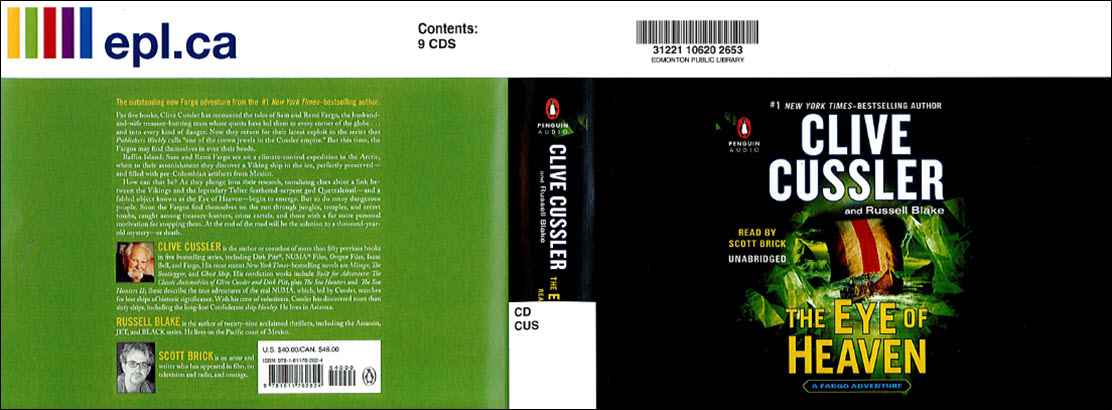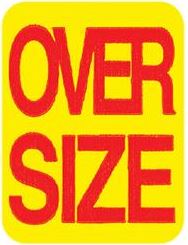Contents
MARC Coding / Fixed Fields
09X Call Number
1XX Main Entry
245 |b
245 |c
250 Abridged/Unabridged edition
300 Physical Description
490/830 Series Statement
5XX Notes
500 Genre Note
511 Performer Note
6XX Subject Headings
7XX Added Entries
Processing
MARC Coding / Fixed Fields
09X Call Number
- Audiobooks in CD format will be catalogued with the same classification as the print collection for adult material:
- Dewey Decimal for the non-fiction, and
- The first 3 letters of the last main entry for fiction.
- However, do not add a date for revised editions, e.g.
Think and Grow Rich by Napoleon Hill
Print Call No: 158.1 HIL 2009
Audiobook Call No: CD 158.1 HIL
- Discrepancies between print and audiobook versions of the same title are accepted in vendor-supplied cataloguing and processing, unless the classification assigned is incorrect (e.g. invalid DDC).
- The classification Christmas is not used for adult spoken sound recordings.
- Indicate language notation as the call number prefix for audiobooks, using the LC Language name* e.g.
Code f.f. LANG fre
099 $aCD French ABC
*Punjabi is preferred over Panjabi
Musical Humour/Parodies
- To determine whether a CD containing musical humour (including musical parodies and satirical songs), is classified in the music or Dewey classification see Non-Classical Sound Recordings
Audiobook Versions of Dramatized Plays
- As per DDC, use the appropriate classification for performances in 79X (except for Shakespeare).
- See [791.4] Public performances -- Motion pictures, radio, television, podcasting for details
1XX Main Entry
Adaptation of Fiction, etc. to Drama
- Since the item is in a different literary form, the main entry will no longer be for the author of the original work (RDA 6.27.1.5); if an adaptor is clearly given on the item, the adaptor will be main entry, but if diffusion is involved or if in doubt, use title as main entry. For clarity, add information in square brackets to the original author’s name, e.g.
245 $c[adapted from] Louis L’Amour.
Fibber McGee & Molly recordings (radio program)
- Main entry is Jordan, Jim (principal performer). Added entry for Jordan, Marian.
PDQ Bach & Peter Schickele
- This is the same person. If both names appear on an item use the most prominent name.
- See also 7XX | Added entries
For sound recordings lacking any overt authorship statement
- Use other types of authorship e.g. "created by _____" found on accompanying book for source of main entry. This is appropriate especially for instructional materials.
245 |bSubtitles
- If a subtitle is on the container or read aloud as on talking books, it may be included in the 245 |b. Alternatively other information should be quoted in 500 note if considered useful.
245 |cStatement of responsibility
- Do not record or make added entry for name of abridger.
250 Abridged/Unabridged edition
- If information is readily available, make a note if item is abridged or unabridged, e.g.
250 $aAbridged edition.
250 $aUnabridged edition.
300
- An audiobook meeting the Oversize criteria is to be labelled Oversize.
- Indicate Oversize on the IP form.
490/830 Series Statement
5XX Notes
500 Fiction Genre/Canadian Creator Notes
- See Print Fiction, 500 Notes.
- Labels are not attached to the physical items (i.e. do not circle genres on In process form for audiobooks).
- Add a fiction genre note only if easily determined; if bibliographic records for print versions have not been assessed for genre, do not assign genre based on compact discs.
500 Repackaged by Midwest Tape
- For audiobooks repackaged by Midwest Tape, in the 264 field record the manufacturing data and add Midwest Tape as a distributor. Also provide a quoted note regarding the repackaging, e.g.
264 1\ |aNew York :|bMacmillan Audiobook,|cp2008.
264 2\ |aHolland, Ohio :|b[distributed by] Midwest Tape,|cp2008.
500 \\ |a“Repackaged by Midwest Tape”—Container.
511 Performer's Note
- Use a note to indicate non-credited performances, etc.; this indicates that data was not present, e.g.
511 |aReader unknown. or
511 |aUnspecified readers.
- If a performer is identical to main entry, do not repeat name. Use a phrase such as, e.g. Read by the author.
6XX Subject Headings
7XX Added Entries
Amos 'n' Andy recordings
- Added author entries should be made for Freeman Gosden and Charles Correll.
Radio plays
- For collection of complete plays:
- Make separate 700's for authors
- Make separate 740's for individual plays
Other added entries
- If a musician is prominently named on a spoken sound recording, include the musician in 511, and trace.
- Do not make 700 for abridger.
Item Entry & Processing
- Affix spine label to insert on the spine at the bottom; font should be 11pt Arial Bold.
- Affix Oversize label directly above spine on insert if the item meets the oversize criteria.
- If Oversize, item Home location = AUDBKOVR and an Oversize label is affixed.
- Affix the scannable barcode on the insert on the front cover side vertically with the bottom of the barcode nearest the spine portion along the centre right hand edge. The barcode may be shifted slightly to avoid obscuring title text.
- A contents label (font is 12pt Arial Bold) is applied under the barcode avoiding covering important information when the item contains more than 1 disc or contains any loose material of more than 4 pages.

- Item entry processors ensure that the 300 field of the bibliographic record matches the contents label.
- Affix the eye-readable barcode to the upper right hand of the booklet (if present).
- Affix an RFID book tag to the inside (i.e. back side) of the sleeve near the spine and close to the bottom edge of the spine, or when the sleeve is not removable, affix the tag near the spine, at the bottom edge of the back of the container and cover it with tape.
- A preprinted 'EDMONTON PUBLIC LIBRARY' donut label should be applied to each of the discs, on each of the donut labels include the last 9 digits of the barcode for that item.

- Repackage those CD items where it is necessary to accommodate an accompanying book/booklet that is too large to fit inside a regular CD jewel case; such repackaging may require changes to the bibliographic record, e.g. 300 field.
- Apply an 'Oversize' Genre label directly above the spine label if it meets the oversize requirements and use home location = AUDBKOVR; see All Formats, Oversize.

- Vendors typically supply audiobooks in "Unikeep-style" cases so no repackaging will be required. If however they do come in a unique or cardboard format they will require repackaging into a plastic unikeep case that will appropriately fit all pieces.
Last revised Jan. 17, 2025